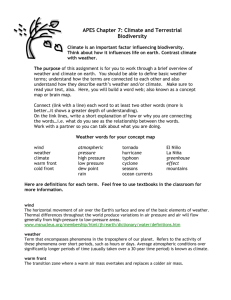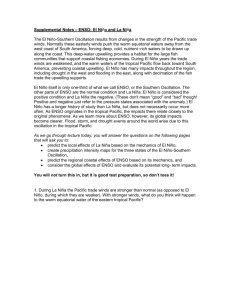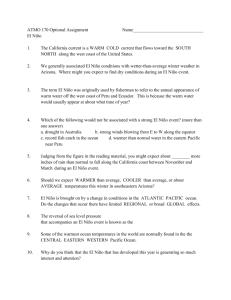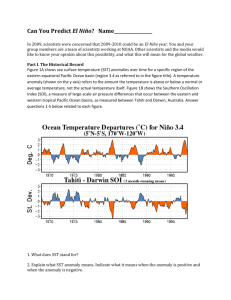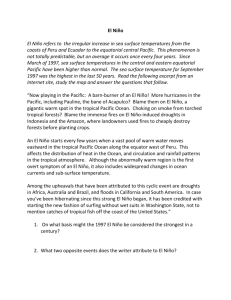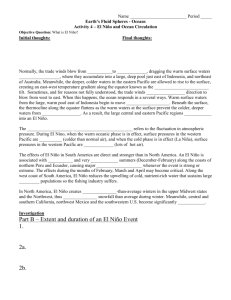Ch08TBAns - Cal State LA
advertisement
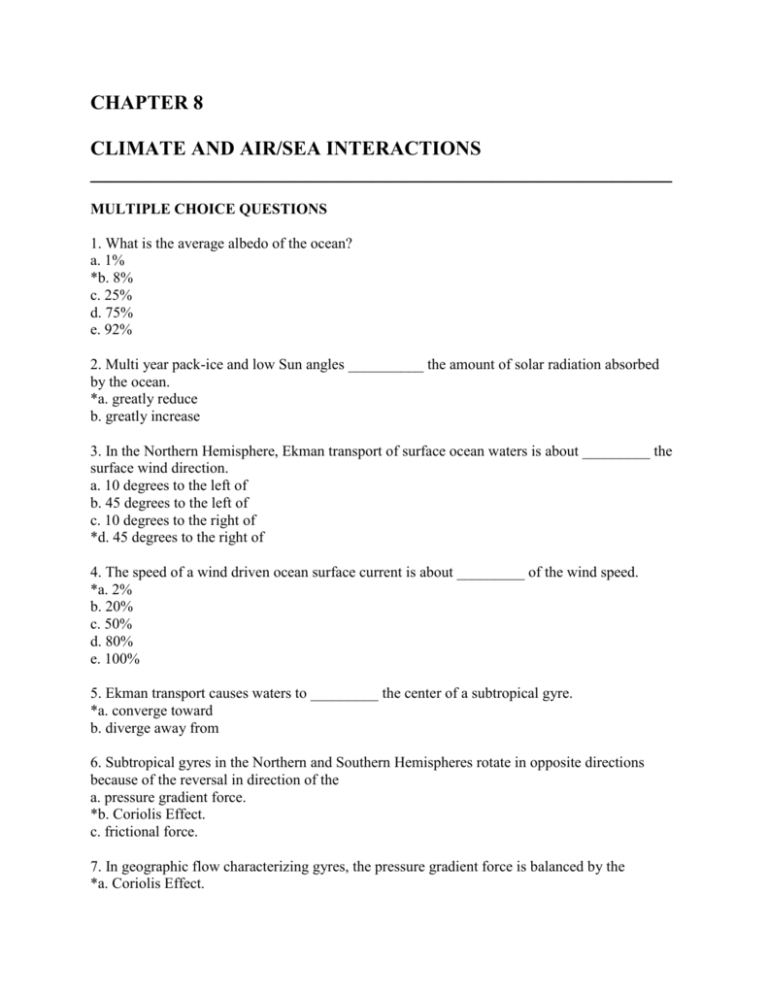
CHAPTER 8 CLIMATE AND AIR/SEA INTERACTIONS __________________________________________________________ MULTIPLE CHOICE QUESTIONS 1. What is the average albedo of the ocean? a. 1% *b. 8% c. 25% d. 75% e. 92% 2. Multi year pack-ice and low Sun angles __________ the amount of solar radiation absorbed by the ocean. *a. greatly reduce b. greatly increase 3. In the Northern Hemisphere, Ekman transport of surface ocean waters is about _________ the surface wind direction. a. 10 degrees to the left of b. 45 degrees to the left of c. 10 degrees to the right of *d. 45 degrees to the right of 4. The speed of a wind driven ocean surface current is about _________ of the wind speed. *a. 2% b. 20% c. 50% d. 80% e. 100% 5. Ekman transport causes waters to _________ the center of a subtropical gyre. *a. converge toward b. diverge away from 6. Subtropical gyres in the Northern and Southern Hemispheres rotate in opposite directions because of the reversal in direction of the a. pressure gradient force. *b. Coriolis Effect. c. frictional force. 7. In geographic flow characterizing gyres, the pressure gradient force is balanced by the *a. Coriolis Effect. b. frictional force. c. wind. d. deep ocean water current. 8. The central regions of sub-polar gyres feature a. downwelling. *b. upwelling. 9. A persistent wind from the south along the California coast would lead to a. coastal upwelling. *b. coastal downwelling. 10. A persistent wind from the south along the coasts of Chile and Peru would lead to *a. coastal upwelling. b. coastal downwelling. 11. Ekman transport north and south of the equator causes the equatorial region to generally feature *a. upwelling. b. downwelling. 12. Upwelling of waters from below the pycnocline generally _________ sea-surface temperatures. *a. decreases b. does not change c. increases 13. Where a decrease in temperature with depth is responsible for the density increase with depth, the pycnocline is also a *a. thermocline. b. halocline. c. photocline. 14. Where an increase in salinity with depth is responsible for the density increase with depth, the pycnocline is also a a. thermocline. *b. halocline. c. photocline. 15. Where are the world’s most productive fisheries found? a. the western boundary regions of subtropical gyres *b. the eastern boundary regions of subtropical gyres c. near the center of a subtropical gyre d. the eastern boundary regions of sub-polar gyres e. None of the above is correct. 16. The deep-ocean circulation driven by variations in density is known as a. downwelling. b. upwelling. c. Ekman transport. *d. thermohaline circulation. e. None of the above is correct. 17. The deep ocean is _________ the wind and surface ocean currents. *a. shielded from b. strongly influenced by 18. The thermohaline circulation is a significant player in the Earth system because it a. controls the basic stratification of the ocean. b. contributes to poleward heat transport. c. modulates climate. *d. All of the above are correct. e. Only a and b are correct. 19. What is the principal method for deep water formation in the Northern Hemisphere? a. equatorial upwelling *b. open ocean convection c. Ekman transport d. El Niño e. coastal upwelling 20. Brine rejection causes ocean water to become *a. more dense. b. less dense. 21. In winter, a source for North Atlantic Ocean deep water is the a. Greenland-Norwegian Sea. b. Labrador Sea. c. salty outflow from the northwestern Mediterranean Sea. *d. All of the above are correct. e. Only a and b are correct. 22. El Niño and La Niña are inter-annual variations in Earth’s climate system occurring in the a. Arctic Ocean. b. Southern Ocean. c. North Atlantic Ocean. d. South Atlantic Ocean. *e. tropical Pacific Ocean. 23. A climate-impacting oscillation involving the atmosphere and ocean: a. ENSO b. North Atlantic Oscillation c. Arctic Oscillation d. Pacific Decadal Oscillation *e. All of the above are correct. 24. The Southern Oscillation a. was discovered by Sir Gilbert Walker early in the 20th century. b. is a seasaw variation in air pressure across the tropical Indian and Pacific Oceans. c. is linked to the development of El Niño. *d. All of the above are correct. e. None of the above is correct. 25. The Southern Oscillation Index (SOI) is based on the difference in anomalous _________ between Darwin and Tahiti. *a. air pressure b. temperature c. dewpoint d. wind speed e. precipitation 26. El Niño can be described as the _________ phase of the Southern Oscillation, and La Niña the _________ phase. *a. warm…...cold b. cold…….warm 27. The Madden-Julian Oscillation (MJO) is important because it is a possible trigger for the *a. ENSO b. North Atlantic Oscillation c. Arctic Oscillation d. Pacific Decadal Oscillation e. All of the above are correct. 28. Weather-related impacts of El Niño and La Niña are a. confined to the Pacific Ocean. *b. present around the world. 29. During “neutral” conditions, sea surface temperatures are highest in the _________ tropical Pacific. *a. western b. central c. eastern 30. The trade winds are ultimately driven by a(n) _________-directed pressure gradient force in the tropical Pacific. a. northward b. southward c. eastward *d. westward 31. The Walker Circulation is a large convective-type circulation where air _________ in the western tropical Pacific and _________ in the eastern tropical Pacific. a. sinks… sinks b. sinks…. rises c. rises…..rises *d. rises….sinks 32. With the onset of El Niño, the trade winds _________ in the western and central equatorial Pacific. *a. slacken b. strengthen 33. In the eastern tropical Pacific during El Niño a. SST rises. b. sea level climbs. c. the thermocline deepens. *d. All of the above are correct. e. None of the above is correct. 34. El Niño causes a. a decline in commercial fish harvest off the coast of Ecuador and Peru. b. coral bleaching. c. anomalously wet weather in Indonesia. d. All of the above are correct. *e. Only a and b are correct. 35. A teleconnection during an El Niño: a. abundant rainfall and cooler than usual conditions in the Gulf states during the winter b. mild winter weather over much of Canada and Alaska c. less frequent incidence of tornadoes in the Ohio and Tennessee River Valleys in spring *d. All of the above are correct. e. Only b and c are correct. 36. La Niña _________ follows El Niño. a. never *b. occasionally c. always 37. The lifetime of a La Niña event is typically a. 30-50 days. b. 1-2 months. *c. 12-18 months. d. 1-2 years. e. 5-7 years. 38. Exceptionally vigorous upwelling along the coast of Ecuador and Peru occurs during a. El Niño *b. La Niña 39. During La Niña, winds tend to be more _________ across the Northern Hemisphere middle latitudes. a. zonal *b. meridional 40. Variations in the Multivariate ENSO Index show that La Niña is more likely to follow _________ El Niño. *a. an intense b. a weak 41. If an El Niño advisory is issued, a. conditions are favorable for El Niño development within the next three months. *b. El Niño conditions have developed and are expected to continue. 42. A coupled atmosphere-ocean model is an example of a(n) *a. dynamical model. b. empirical model. c. physical model. 43. A component of the ENSO Observing System: a. TAO/TRITON array of moored buoys b. tide gauges c. ship-based measurements d. satellites *e. All of the above are correct. 44. Sensors on the satellite Jason 2 *a. map ocean surface topography. b. monitor clouds and precipitation. c. examine thermocline temperatures. d. monitor wind speeds. e. All of the above are correct. 45. The North Atlantic Oscillation refers to a seesaw variation in air pressure between a. New York and London. b. the Bahamas and the Cape Verde Islands. *c. Iceland and the Azores. d. Brazil and South Africa. e. Bermuda and Spain. 46. Which coupled atmosphere-ocean oscillation directly alters the speed of the polar vortex? a. ENSO b. North Atlantic Oscillation *c. Arctic Oscillation d. Pacific Decadal Oscillation 47. The United States is more likely to experience bitterly cold Arctic air masses when the polar vortex circulation is *a. weaker than usual. b. stronger than usual. 48. The recent episode of dominantly _________ AO phase may at least partially explain the shrinkage of Arctic sea ice. a. negative *b. positive 49. Which coupled atmosphere-ocean oscillation directly influences salmon fisheries along the Pacific Northwest Coast? a. ENSO b. North Atlantic Oscillation c. Arctic Oscillation *d. Pacific Decadal Oscillation 50. Pacific Northwest mountain snow pack thickens during the PDO *a. cool phase. b. warm phase. c. neutral phase.
